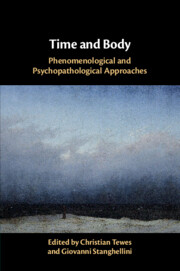Book contents
- Time and Body
- Endorsements for Time and Body
- Time and Body
- Copyright page
- Dedication
- Additional material
- Contents
- Figures
- Contributors
- 1 Introduction – Time and Body
- 2 Time, the Body, and the Other in Phenomenology and Psychopathology
- Part I Body and Time: General Aspects
- Part II Grief and Anxiety
- Part III Borderline Personality and Eating Disorders
- Part IV Depression, Schizophrenia, and Dementia
- Index
- References
1 - Introduction – Time and Body
Phenomenological and Psychopathological Approaches
Published online by Cambridge University Press: 30 October 2020
- Time and Body
- Endorsements for Time and Body
- Time and Body
- Copyright page
- Dedication
- Additional material
- Contents
- Figures
- Contributors
- 1 Introduction – Time and Body
- 2 Time, the Body, and the Other in Phenomenology and Psychopathology
- Part I Body and Time: General Aspects
- Part II Grief and Anxiety
- Part III Borderline Personality and Eating Disorders
- Part IV Depression, Schizophrenia, and Dementia
- Index
- References
Summary
The relations between embodiment and temporality reach from the micro-temporality of conscious experience to the enactment of human existence. First, the basic internal time consciousness is marked by the rhythmicity of vital processes (heart beat, respiratory rhythm, daily periods, etc.). Moreover, the bodily drives, urges, and needs, which may be subsumed under the term conation, crucially determine the future-directed temporality of primary experience. On the other hand, the body forms an extract of sensorimotor and affective experience which are sedimented in implicit or body memory, thus shaping an individual's capacities and dispositions. Finally, existential temporality is essentially characterized by the vital processes of birth, growth, aging, and dying.
Body, time, and intersubjectivity are equally interconnected. First, interbodily resonance establishes the primary experience of the shared present, beginning in the child's early development. Thus, a basic contemporality emerges, which later continues in social synchronizations and temporal orders as the basis of social life. However, this temporal alignment is also subject to desynchronizations, for example, in backlogs of tasks, in guilt, remorse, or grief – situations that require processes of psychosocial resynchronization.
All these interconnections are subject to various kinds of disturbances which are also found in psychopathology and thus crucially determine the emergence and course of mental disorders.
Keywords
- Type
- Chapter
- Information
- Time and BodyPhenomenological and Psychopathological Approaches, pp. 1 - 11Publisher: Cambridge University PressPrint publication year: 2020



